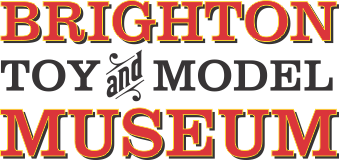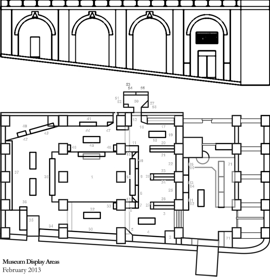Frank Hornby: Difference between revisions
(links) |
(Things named after Frank Hornby) |
||
| Line 1: | Line 1: | ||
{{Toymaker}} | {{Toymaker}}{{FH150}} | ||
'''Frank Hornby (1863-1936)''' has the distinction of being responsible for originating not just one, but ''three'' of the biggest British toy brands. | '''Frank Hornby (1863-1936)''' has the distinction of being responsible for originating not just one, but ''three'' of the biggest British toy brands. | ||
| Line 6: | Line 6: | ||
===Hornby Trains/ Hornby Railways / Hornby Dublo=== | ===Hornby Trains/ Hornby Railways / Hornby Dublo=== | ||
Next came [[Hornby Trains]] / [[Hornby | Next came [[Hornby Trains]] / [[Hornby Railways]]. Since Hornby was already making toys that used all-metal wheels and parts, metal locomotives and carriages were an obvious development. The UK market had been dominated by the German brands [[Marklin]] and [[Bing]], but during WW1,Hornby realised that German imports wouldn't be as popular after the War, and started planning tolaunch a range of trains and train setsonce the War had finished and the supply chain normaised. | ||
After [[Bing]] and [[Bassett-Lowke]] had brought out their "[[table railway]]" [[00-gauge]] format trains, Hornby recognised that the smaller size and reduced material costs opened up the model railway format to a range of potential customers who couldn't afford the price or the space needed for a [[gauge 0]] layout, and produced [[Hornby Dublo]]. | |||
===Dinky Toys=== | ===Dinky Toys=== | ||
| Line 14: | Line 16: | ||
* ''Anthony McReavy'' '''The Toy Story: The Life and Times of Inventor Frank Hornby''' (Ebury Press, 2002) ISBN 009188117X | * ''Anthony McReavy'' '''The Toy Story: The Life and Times of Inventor Frank Hornby''' (Ebury Press, 2002) ISBN 009188117X | ||
* ''M.P. Gould'' '''Frank Hornby: The Boy Who Made $1,000,000 with a Toy''' -- a small-format book written for the American market, with the help of FH. The reprinted book is a curiosity to modern eyes, with its Victorian-sounding commentary out-Baden-Powelling Baden-Powell. Also available online (see below) | * ''M.P. Gould'' '''Frank Hornby: The Boy Who Made $1,000,000 with a Toy''' -- a small-format book written for the American market, with the help of FH. The reprinted book is a curiosity to modern eyes, with its Victorian-sounding commentary out-Baden-Powelling Baden-Powell. Also available online (see below) | ||
==Things named after Frank Hornby== | |||
* '''British Rail "Class 56" diesel locomotive number 56101''' is named the "Frank Hornby". The locomotive now appears to have been sold and shipped to Hungary http://www.class56group.co.uk/archives/tag/56101 . | |||
* '''[http://www.jdwetherspoon.co.uk/home/pubs/the-frank-hornby "The Frank Hornby" (jdwetherspoon.co.uk)]''' is a J.D. Wetherspoons pub in maghull, Liverpool. | |||
{{links}} | {{links}} | ||
Revision as of 20:35, 4 December 2012
| Toy Brands and Manufacturers |
|---|
Frank Hornby |
Frank Hornby (1863-1936) has the distinction of being responsible for originating not just one, but three of the biggest British toy brands.
Meccano
First came Meccano, a construction toy that started out as "Mechanics Made Simple", and which evolved into a smoother more stylised form that we now recognise as the classic Meccano shapes.
Hornby Trains/ Hornby Railways / Hornby Dublo
Next came Hornby Trains / Hornby Railways. Since Hornby was already making toys that used all-metal wheels and parts, metal locomotives and carriages were an obvious development. The UK market had been dominated by the German brands Marklin and Bing, but during WW1,Hornby realised that German imports wouldn't be as popular after the War, and started planning tolaunch a range of trains and train setsonce the War had finished and the supply chain normaised.
After Bing and Bassett-Lowke had brought out their "table railway" 00-gauge format trains, Hornby recognised that the smaller size and reduced material costs opened up the model railway format to a range of potential customers who couldn't afford the price or the space needed for a gauge 0 layout, and produced Hornby Dublo.
Dinky Toys
To supplement their gauge 0 railways, Hornby started producing a range of matching 1/43-scale trackside accessories such as signal boxes and stations, and if a customer had a model railway layout with level crossings and bridges and houses and roads, what they needed to complete the set was a matching range of 1/43-scale cars, which Hornby then obligingly produced. Since these could also be sold to people who didn't actually own a train set, Hornby gave them a separate brandname: "Dinky Toys".
Books
- Anthony McReavy The Toy Story: The Life and Times of Inventor Frank Hornby (Ebury Press, 2002) ISBN 009188117X
- M.P. Gould Frank Hornby: The Boy Who Made $1,000,000 with a Toy -- a small-format book written for the American market, with the help of FH. The reprinted book is a curiosity to modern eyes, with its Victorian-sounding commentary out-Baden-Powelling Baden-Powell. Also available online (see below)
Things named after Frank Hornby
- British Rail "Class 56" diesel locomotive number 56101 is named the "Frank Hornby". The locomotive now appears to have been sold and shipped to Hungary http://www.class56group.co.uk/archives/tag/56101 .
- "The Frank Hornby" (jdwetherspoon.co.uk) is a J.D. Wetherspoons pub in maghull, Liverpool.


